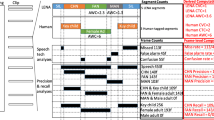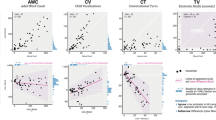Abstract
Understanding and assessing child verbal communication patterns is critical in facilitating effective language development. Typically speaker diarization is performed to explore children’s verbal engagement. Understanding which activity areas stimulate verbal communication can help promote more efficient language development. In this study, we present a two-stage children vocal engagement prediction system that consists of (1) a near to real-time, noise robust system that measures the duration of child-to-adult and child-to-child conversations, and tracks the number of conversational turn-takings, (2) a novel child location tracking strategy, that determines in which activity areas a child spends most/least of their time. A proposed child–adult turn-taking solution relies exclusively on vocal cues observed during the interaction between a child and other children, and/or classroom teachers. By employing a threshold optimized speech activity detection using a linear combination of voicing measures, it is possible to achieve effective speech/non-speech segment detection prior to conversion assessment. This TO-COMBO-SAD reduces classification error rates for adult-child audio by 21.34% and 27.3% compared to a baseline i-Vector and standard Bayesian Information Criterion diarization systems, respectively. In addition, this study presents a unique location tracking system adult-child that helps determine the quantity of child–adult communication in specific activity areas, and which activities stimulate voice communication engagement in a child–adult education space. We observe that our proposed location tracking solution offers unique opportunities to assess speech and language interaction for children, and quantify the location context which would contribute to improve verbal communication.











Similar content being viewed by others
References
Anguera, X., Bozonnet, S., Evans, N., Fredouille, C., Friedland, G., & Vinyals, O. (2012). Speaker diarization: A review of recent research. IEEE Transactions on Audio, Speech, and Language Processing, 20(2), 356–370.
Bahari, M. H., McLaren, M., van Leeuwen, D. A., et al. (2014). Speaker age estimation using i-vectors. Engineering Applications of Artificial Intelligence, 34, 99–108.
Barras, C., Zhu, X., Meignier, S., & Gauvain, J.-L. (2006). Multistage speaker diarization of broadcast news. IEEE Transactions on Audio, Speech, and Language Processing, 14(5), 1505–1512.
Boersma, P. (1993). Accurate short-term analysis of the fundamental frequency and the harmonics-to-noise ratio of a sampled sound. In: Proceedings of the institute of phonetic sciences (Vol. 17, pp. 97–110). Amsterdam.
Bonastre, J.-F., Scheffer, N., Matrouf, D., Fredouille, C., Larcher, A., Preti, A., Pouchoulin, G., Evans, N.W., Fauve, B.G., & Mason, J.S. (2008). ALIZE/spkdet: A state-of-the-art open source software for speaker recognition. In: Odyssey. p. 20.
Connaghan, D., Hughes, S., May, G., Kelly, P., Conaire, C.Ó., O’Connor, N.E., O’Gorman, D., Smeaton, A.F., & Moyna, N. (2009). A sensing platform for physiological and contextual feedback to tennis athletes. In: Wearable and implantable body sensor networks, 2009 (pp. 224–229). BSN 2009. IEEE.
Cortes, C., & Vapnik, V. (1995). Support-vector networks. Machine Learning, 20(3), 273–297.
Dehak, N., Kenny, P. J., Dehak, R., Dumouchel, P., & Ouellet, P. (2011a). Front-end factor analysis for speaker verification. IEEE Transactions on Audio, Speech, and Language Processing, 19(4), 788–798.
Dehak, N., Torres-Carrasquillo, P.A., Reynolds, D., & Dehak, R. (2011b). Language recognition via i-vectors and dimensionality reduction. In Twelfth Annual Conference of the International Speech Communication Association, INTERSPEECH.
Delano, M., & Snell, M. E. (2006). The effects of social stories on the social engagement of children with autism. Journal of Positive Behavior Interventions, 8(1), 29–42.
Gauvain, J.-L., & Lee, C.-H. (1991). Bayesian learning of Gaussian mixture densities for hidden Markov models. In Speech and natural language: Proceedings of a Workshop Held at Pacific Grove, California, 19-22 February, 1991.
Ghaemmaghami, H., Dean, D., & Sridharan, S. (2015). A cluster-voting approach for speaker diarization and linking of Australian broadcast news recordings. In ICASSP (pp. 4829–4833). IEEE.
Ghaemmaghami, H., Dean, D., Vogt, R. & Sridharan, S. (2011). Extending the task of diarization to speaker attribution. In Interspeech 2011, 28–31 August 2011, Florence.
Graciarena, M., Alwan, A., Ellis, D., Franco, H., Ferrer, L., Hansen, J.H., Janin, A., Lee, B.S., Lei, Y., & Mitra, V., et al., (2013). All for one: feature combination for highly channel-degraded speech activity detection. In INTERSPEECH (pp. 709–713).
Gravier, G., Betser, M., & Ben, M. (2010). AudioSeg: Audio segmentation toolkit, release 1.2. IRISA, January.
Gupta, R., Bone, D., Lee, S., & Narayanan, S. (2016). Analysis of engagement behavior in children during dyadic interactions using prosodic cues. Computer Speech & Language, 37, 47–66.
Hart, B., & Risley, T. R. (1995). Meaningful differences in the everyday experience of young American children. Baltimore, MD: Paul H Brookes Publishing.
Huijbregts, M. A.H. (2008). Segmentation, diarization and speech transcription: Surprise data unraveled. Ph.D. thesis, Centre for Telematics and Information Technology University of Twente.
Kasari, C., Gulsrud, A. C., Wong, C., Kwon, S., & Locke, J. (2010). Randomized controlled caregiver mediated joint engagement intervention for toddlers with autism. Journal of Autism and Developmental Disorders, 40(9), 1045–1056.
Meignier, S., & Merlin, T. (2010). Lium spkdiarization: an open source toolkit for diarization. In CMU SPUD Workshop (Vol. 2010). Le Mans: Universite du Maine.
Meignier, S., Moraru, D., Fredouille, C., Bonastre, J.-F., & Besacier, L. (2006). Step-by-step and integrated approaches in broadcast news speaker diarization. Computer Speech & Language, 20(2), 303–330.
Najafian, M., Irvin, D., Luo, Y., Rous, B.S., & Hansen, J.H. (2016). Employing speech and location information for automatic assessment of child language environments. In Sensing, processing and learning for intelligent machines (SPLINE). IEEE, pp. 1–5.
Phebey, T. (2010). The Ubisense assembly control solution for BMW solution for BMW. Proccedings of RFID Journal Europe Live. Retrieved 18 August, 2016.
Reynolds, D.A., Singer, E., Carlson, B.A., O’Leary, G.C., McLaughlin, J.J., & Zissman, M.A. (1998). Blind clustering of speech utterances based on speaker and language characteristics. In Fifth International Conference on spoken language processing—ICSP.
Riehle, T.H., Lichter, P., Giudice, N.A. (2008). An indoor navigation system to support the visually impaired. In Engineering in Medicine and Biology Society, 2008. EMBS 2008. 30th Annual International Conference of the IEEE. IEEE, pp. 4435–4438.
Sadjadi, S. O., & Hansen, J. H. (2013). Unsupervised speech activity detection using voicing measures and perceptual spectral flux. IEEE Signal Processing Letters, 20(3), 197–200.
Safavi, S., Russell, M., & Jančovič, P. (2014). Identification of age-group from children’s speech by computers and humans. In Fifteenth Annual Conference of the International Speech Communication Association—INTERSPEECH.
Scheirer, E., & Slaney, M. (1997). Construction and evaluation of a robust multifeature speech/music discriminator. In IEEE International Conference on acoustics, speech, and signal processing, 1997. IEEE. ICASSP-97 (Vol. 2, pp. 1331–1334).
Siegler, M.A., Jain, U., Raj, B., & Stern, R.M., (1997). Automatic segmentation, classification and clustering of broadcast news audio. In Proceedings of DARPA speech recognition workshop. Vol. 1997.
Swedberg, C. (2011). Bmw finds the right tool. RFID Journal, 1, 2009.
Tranter, S. E., & Reynolds, D. A. (2006). An overview of automatic speaker diarization systems. IEEE Transactions on Audio, Speech, and Language Processing, 14(5), 1557–1565.
Vijayasenan, D., & Valente, F. (2012). Diartk: An open source toolkit for research in multistream speaker diarization and its application to meetings recordings. In Thirteenth Annual Conference of the International Speech Communication Association—INTERSPEECH. Portland.
Walker, D., Greenwood, C., Hart, B., & Carta, J. (1994). Prediction of school outcomes based on early language production and socioeconomic factors. Child Development, 65, 606–621.
Woźniak, M., Odziemczyk, W., & Nagórski, K. (2013). Investigation of practical and theoretical accuracy of wireless indoor positioning system ubisense. Reports on Geodesy and Geoinformatics, 95(1), 36–48.
Yella, S. H. (2015). Speaker diarization of spontaneous meeting room conversations. PhD thesis, EPFL, Lausanne.
Zhao, Q., Kawamata, M., & Higuchi, T. (1988). Controllability, observability and model reduction of separable denominator MD systems. IEICE Transactions (1976–1990), 71(5), 505–513.
Ziaei, A., Kaushik, L., Sangwan, A., Hansen, J.H., & Oard, D.W. (2014). Speech activity detection for nasa apollo space missions: Challenges and solutions. In Fifteenth Annual Conference of the International Speech Communication Association.
Ziaei, A., Sangwan, A., & Hansen, J.H. (2013). Prof-Life-Log: Personal interaction analysis for naturalistic audio streams. In 2013 IEEE International Conference on Acoustics, Speech and Signal Processing (ICASSP) (pp. 7770–7774). IEEE.
Acknowledgements
Authors wish to express our sincere thanks to Univ. of Kentucky for the joint collaboration efforts on this study. In particular, wish to thank Ying Luo for collecting, organizing the child database used in this study.
Author information
Authors and Affiliations
Corresponding author
Additional information
Publisher’s Note
Springer Nature remains neutral with regard to jurisdictional claims in published maps and institutional affiliations.
Rights and permissions
About this article
Cite this article
Hansen, J.H.L., Najafian, M., Lileikyte, R. et al. Speech and language processing for assessing child–adult interaction based on diarization and location. Int J Speech Technol 22, 697–709 (2019). https://doi.org/10.1007/s10772-019-09590-0
Received:
Accepted:
Published:
Issue Date:
DOI: https://doi.org/10.1007/s10772-019-09590-0




